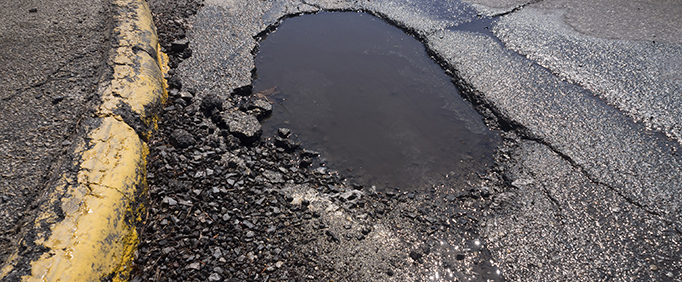 Potholes form when moisture collects in small holes and cracks in the road surface. As temperatures rise and fall, the moisture expands and contracts due to freezing and thawing. This breaks up the pavement and, combined with the weight of passing cars, eventually results in a pothole.
Potholes form when moisture collects in small holes and cracks in the road surface. As temperatures rise and fall, the moisture expands and contracts due to freezing and thawing. This breaks up the pavement and, combined with the weight of passing cars, eventually results in a pothole.
To aid motorists in protecting their vehicles from pothole damage, AAA recommends the following:
Inspect Tires – Make sure tires are properly inflated and have enough tread . An underinflated or badly worn tire is more likely to suffer damage, or allow the wheel or suspension to be damaged, when hitting a pothole. When checking tire pressures, ensure they are inflated to the manufacturer’s recommended levels, which can be found in the owner’s manual or on a sticker on the driver’s door jamb. Do not use the pressure levels stamped on the sidewall of the tire. To check the tread depth, insert a quarter into the tread groove with Washington’s head upside down. The tread should cover part of Washington’s head. If it doesn’t, then it’s time to start shopping for new tires.
Inspect Suspension – Make certain struts, shock absorbers and other suspension parts are in good condition. Changes in vehicle handling, excessive vibration or uneven tire wear can indicate damaged or worn components. Have the suspension inspected by a certified technician if you suspect problems.
Look Ahead – Make a point of checking the road ahead for potholes. An alert driver may have time to avoid potholes, so it’s important to stay focused on the road and not any distractions inside or outside the vehicle. Before swerving to avoid a pothole, check surrounding traffic to ensure this won’t cause a collision or endanger nearby pedestrians or cyclists.
Slow Down – If a pothole cannot be avoided, reduce speed safely being sure to check the rear view mirror before any abrupt braking. Hitting a pothole at higher speeds greatly increases the chance of damage to tires, wheels and suspension components
Beware of Puddles – A puddle of water can disguise a deep pothole. Use care when driving through puddles and treat them as though they may be hiding potholes.
Check Alignment – Hitting a pothole can knock the wheels out of alignment and affect the steering. If a vehicle pulls to the left of right, have the wheel alignment checked by a qualified technician.
Recognize Noises/Vibrations – A hard pothole impact can dislodge wheel weights, damage a tire or wheel, and bend or even break suspension components. Any new or unusual noises or vibrations that appear after hitting a pothole should be inspected immediately by a certified technician.

Leave a comment